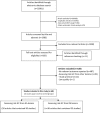Gastric cancer in patients with gastric atrophy and intestinal metaplasia: A systematic review and meta-analysis
- PMID: 31348819
- PMCID: PMC6660080
- DOI: 10.1371/journal.pone.0219865
Gastric cancer in patients with gastric atrophy and intestinal metaplasia: A systematic review and meta-analysis
Abstract
Aim: Intestinal metaplasia (IM) and gastric atrophy (GA) are precancerous lesions in the stomach. There is a large debate on natural course of these lesions and surveillance strategy in these patients. This meta-analysis was aimed to find the most appropriate follow up and the rate of progression from IM and GA to GC.
Methods: This meta-analysis is followed and reported according to the Preferred Reporting Items for Systematic Reviews and Meta-Analyses (PRISMA) guidelines. Electronic databases including EMBASE, PubMed, Web of Science databases, Scopus, and the Cochrane Library were searched until July 2018. Cochran's Q test and I-square (I2) test were used to examine heterogeneity across included studies. We pooled data using random-effect or fixed effect models indicated as incidence rate or proportion with 95% confidence intervals (CI). The variables of study included demographic data, endoscopy interval, follow up interval and time, GA and IM type and GC stage. Moreover, incidence rate of GC and progress rate, regress and persistence proportion in both GA and IM patients were assessed.
Results: Overall, 68 original articles out of 32981 citations were included in our meta-analysis. The pooled GC incidence rate in patients with GA was 1.24 (95% CI, 0.80, 1.76; I2: 83.6%) cases per 1,000 person-years. The rates of later diagnosis of IM and gastric dysplasia in patients with GA were estimated as 41.42 (95% CI, 3.11, 64.45; I2: 95.6%) and 6.23 (95% CI, 2.34, 11.46; I2: 83.0%) cases per 1,000 person-years, respectively. The pooled regressed proportion was 32.23 (95% CI, 18.07-48.02; I2: 94.0%) and the persistence proportion was 38.83 (95% CI, 20.20-59.13; I2: 97.0%) per 100 observations in GA patients. In IM studies, the pooled incidence rate of GC was 3.38 (95% CI, 2.13, 4.85; I2: 93.4%) cases per 1,000 person-years. The progressed rate to dysplasia in IM patient was estimated to be 12.51 (95% CI, 5.45, 22.03; I2: 95.1%) cases per 1,000 person-years. The pooled regressed proportion was 31.83 (95% CI, 25.48-38.51; I2: 91.0%) and the persistence proportion was 43.46 (95% CI, 32.52-54.71; I2: 96.0%) per 100 observations in IM patients.
Conclusion: Overall, the incidence of GC in patients with IM and GA are low but there is heterogeneity in data with the highest rate in Asian, males with those with incomplete IM. There is probability of regression or persistence without progression in patients with IM and GA who receive appropriate management.
Conflict of interest statement
The authors have declared that no competing interests exist.
Figures


References
-
- Fitzmaurice C, Allen C, Barber RM, Barregard L, Bhutta ZA, Brenner H, et al. Global, regional, and national cancer incidence, mortality, years of life lost, years lived with disability, and disability-adjusted life-years for 32 cancer groups, 1990 to 2015: a systematic analysis for the global burden of disease study. JAMA oncology. 2017;3(4):524–48. 10.1001/jamaoncol.2016.5688 - DOI - PMC - PubMed
-
- Forman D, Bray F, Brewster D, Gombe Mbalawa C, Kohler B, Piñeros M, et al. Cancer incidence in five continents, vol. X (electronic version) Lyon, IARC; 2013. - PubMed
Publication types
MeSH terms
LinkOut - more resources
Full Text Sources
Medical
Miscellaneous

